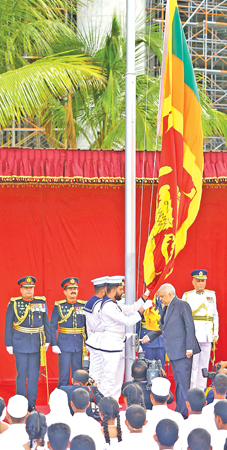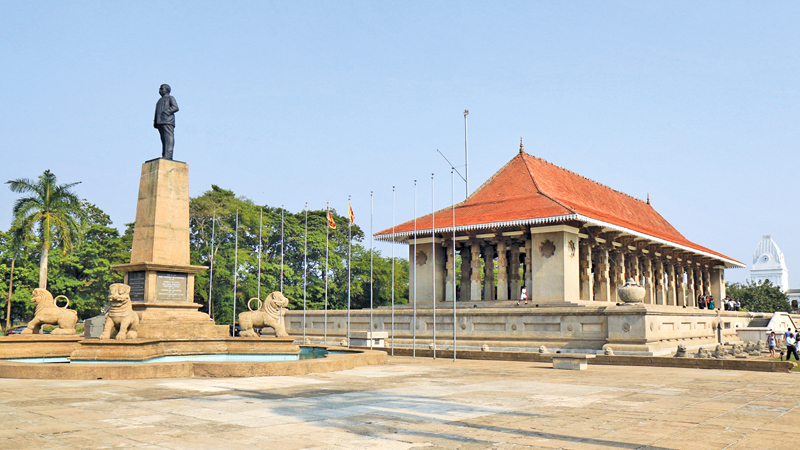
Today as we celebrate our 76th Independence Day, watching the procession of the Tri Forces and Police marching, watching the gathering of dignitaries, and observing the pomp and pageantry, let us not forget the true meaning of Independence Day. And that is, we are one people united. Though the Sinhalese form the majority of our population, let us listen to what the Tamils, the Moors, Indian Tamils, Burghers, Malays and Veddahs say– “We are not Sinhalese, but very much Sri Lankan!”
As an island nation we have a distinct identity, formed by various influences, religious and cultural and we have beautiful traditions. Since independence Sri Lanka has come across many problems in its nation-building process and has not yet completely resolved its ethnic problems. However, our aim should be to create a united Sri Lanka in the true sense of the term. As a people we have faced many tragedies and much suffering, such as the tsunami of 2004, the civil war in Sri Lanka, the Easter Attacks of 2019, Covid19 and the Economic Crisis. However, this has only made us more resilient as a nation.
True Sri Lankan spirit
We are not just a flag, fluttering in the wind. We must understand that the flag represents our Sri Lankan spirit. That is the importance of the flag. The Independence Memorial Hall is a monument of magnificence and a monument of pride. The Lions statues guarding the Independence Memorial Hall are magnificent, but we will only hear their deafening roar when we remember who we are. When we remember our spirit. Its true purpose is not to attract foreign and local tourists; its true purpose is to remind us of who we are.
National pride
The hoisting of the national flag stands for national pride. The necessity of a National Flag was felt before the attainment of Independence for Sri Lanka on February 4, 1948. On January 16, 1948, A. Sinne Lebbe, the Honorary Member of Parliament for Batticaloa, proposed that the Lion Flag of Sri Wickrama Rajasinghe, which was taken to England in 1815, be adopted as the National Flag. D.S. Senanayake proposed the names of many distinguished individuals to give advice on the National Flag. In response to an advertisement published in the newspapers, a large number of representations were received by the committee in Sinhala, Tamil and English.
 At a meeting held on February 13, 1950, it was decided to accept the National Flag which depicted the Lion used by the Sinhala Kings on a red background. Representing the two minorities – Tamil and Muslim, Saffron and Green colours respectively, using two stripes, and the Lion looking at these two stripes were included. There is also a yellow stripe running right around the flag.
At a meeting held on February 13, 1950, it was decided to accept the National Flag which depicted the Lion used by the Sinhala Kings on a red background. Representing the two minorities – Tamil and Muslim, Saffron and Green colours respectively, using two stripes, and the Lion looking at these two stripes were included. There is also a yellow stripe running right around the flag.
Many people sometimes ask, why is there a lion on the flag when there are no lions in Sri Lanka today? The Lion represents bravery. And in time to come with the tragedies we faced as a people during this century, this symbol would truly come to life.
Four Bo leaves
We are told that the four Bo leaves in the flag represent concepts of Metta, loving-kindness; Karuna, compassion; Mudita, sympathetic joy; and Upekkha, equanimity. According to Buddhist tradition and teachings, the Buddha sat under the Bo tree, and attained Enlightenment. Prince Siddhartha left his palace to seek the truth. And he did this out of compassion for mortal beings. Therefore, the Bo tree leaves on the flag may very well be a symbol of compassion. The Bo tree leaves on the flag may also be symbolic of truth, knowledge and wisdom. The Buddha did not seek the truth only for his community but for all human beings. Therefore, by including the Saffron and Green stripes along with the Bo leaves, the flag means that we are one family, and that we should practice loving kindness towards one another.
The accepted Flag with the recommendations of the Flag committee was presented to the parliament on March 2, 1951, by Prime Minister D.S. Senanayake. After two days of live discussions, the National Flag was accepted by Parliament with a majority vote of 30. The accepted National Flag was hoisted at the House of Representatives on March 31, 1951. Thereafter at every National Day celebration, it was the National Flag recommended by the Flag Committee and accepted by Parliament that was hoisted.
Independence Memorial Hall
Independence Memorial Hall was built for commemoration of the independence of Sri Lanka from the British rule in 1948 and therefore a great landmark of Sri Lanka.The Independence Hall is now a venue for the most important events in Sri Lanka, such as Independence celebrations, including funerals of statesmen. But its true purpose is to remind us of who we are. The exterior of the hall is decorated with ‘pots of plenty’ signifying prosperity. When you look at the hall guarded by these lions, and then you look at the surrounding environs, you realise that even though everything around the hall changes, the hall itself is forever. Therefore, funerals of statesmen at the hall have deep meaning. It means that Sri Lanka will always have patriotic leaders who will guard our sovereignty.
Here we are reminded of a poem by John Donne – “Death, be not proud, though some have called thee, mighty and dreadful, for thou are not so….”
The Independence Memorial Hall and the flag is a story of a proud people, a people who love this country. It can be called a story that will never end. The Independence Memorial Hall or the Independence Commemoration Hall in the Independence Square reminds us of the proud identity of the Kandyan Period, the last Kingdom of Sri Lanka, and therefore the freedom of the country that was finally achieved in 1948.
Independence struggle
When we talk of Independence we cannot forget the contribution that Lake House made to the Independence struggle.
There is no doubt that Lake House has contributed to the independence movement in a magnificent way through the vision of its founder D.R. Wijewardene, a man of great deeds. And it retains the same values today that it had then, when it joined the struggle for freedom. The one-time Chief Editor of the Daily News H.A.J. Hulugalle wrote, ‘Before he was fifty, D. R. Wijewardene had established several flourishing newspapers, built up a great business and influenced the course of the Island’s history.”
D.R. Wijewardene, participated in the country’s freedom struggle in two ways. First, he himself was actively involved in working with politicians of the day to advocate political and socio economic aspirations of the people. Secondly, by producing several newspapers in three languages, he was instrumental in shaping the public opinion towards the freedom struggle. He realised the importance of a well-informed public opinion as a force for the freedom struggle. To this end he gradually built up a vast newspaper industry in the country.
In 1914, D. R. Wijewardene and his brother, Don Charles Wijewardene, bought the rights of the Sinhala newspaper, Dinamina, and transformed it into a dynamic “daily” in the Island. In 1918, motivated by this success, D. R. Wijewardene bought an English paper, the Ceylonese, and changed its name to Daily News. He also purchased the publication of a Tamil language daily Thinakaran.
In 1923 he purchased The Observer, which was already 90 years old, having begun publishing in 1834. The Sinhala weekly Silumina was started in 1930. Thus, he was instrumental in arousing the patriotic and nationalist aspirations of the nation.
The military parade has special significance as we honour the officers of the Army, Navy, Air Force, Police and the Civil Defense Force who serve our country and those who sacrificed their lives for this country. Freedom from colonialism is one freedom struggle we overcame, and the other struggle we overcame was against the LTTE.
Celebrating Independence last year was not a popular choice to make. It was a bold one. Many felt that the country could not afford to have one. However, the President felt that if we do not celebrate independence, the world would think we are weak. Those present at Galle Face Green that day understood that this celebration actually strengthened our national pride. Today we celebrate Independence under very different circumstances. Most of our troubles are over. The future is promising. We can be optimistic about our future now.






